I call this a course on “nonsense” for a reason: I am a skeptic by personality and my scientific profession. I support explanations of natural and historical events that are the simplest and best fit the available evidence (using the principle of Occam’s Razor when appropriate). I encourage full and robust discussions on all topics of interest, and I am open to being shown I am wrong. (As a working scientist, I am accustomed to being told by the public exactly how and why I am wrong … especially on evolution, climate change and Bigfoot!)
In this course and the following web text, I will pose many provocative questions and refer you to the broadest range of literature I can find. Please keep in mind, though, my own position and its inherent biases. For example, I am convinced that the modern theory of evolution is the best explanation for life’s diversity, that the Earth is more than 4.5 billion years old (and it’s spherical, for goodness sakes), that the Holocaust was an attempted extermination of Jews in which six million were murdered, that climate change is currently being driven by anthropogenic warming, that on September 11, 2001, terrorists hijacked American passenger jets and flew them into the World Trade Center towers and the Pentagon, and that vaccines do not cause autism. I will always entertain alternative ideas, debating them on their merits, and student work will always be evaluated on the rigor of its analysis, not its conclusions. This is a course in critical thinking, not indoctrination.
That said, off we go into the world of nonsense!
Let’s start our links with a few general resources you will want throughout the semester. The Committee for Skeptical Inquiry has many useful sections, including articles and an index to their magazine (Skeptical Inquirer –– I have many years of back issues).
The Skeptics Society is also an excellent resource for sorting out sense and nonsense. They publish Skeptic magazine and other items.
There are dozens of other major websites which take a skeptical viewpoint on popular topics. We will cite most of them as we cover particular topics. For now, though, you might want to visit the National Center for Science Education (“defending the teaching of evolution and climate science” — my heroes), the Encyclopedia of American Loons, and the The Skeptic’s Dictionary.
I am a big fan of podcasts, all of which I download from iTunes (although I’ll link you below to their host pages). Along with news and general science podcasts, I enjoy The Skeptics’ Guide to the Universe, produced by the authors of our textbook, and Science Vs. My guilty pleasures include: The Gralien Report, Skeptiko, The Higherside Chats, and the always delightfully arrogant Answers in Genesis.
As for YouTube, I’m a slave to their clever algorithm. When I’m choosing channels, I like SciManDan, the hyperbolic bleach-drinking QAnon apologist Destroying the Illusion, and Center for Inquiry. Most of the time, though, I just surf delightfully random nonsense videos. (There are many!)
We will begin to highlight “nonskeptical” (credulous?) webpages next week. You’ve probably found plenty on your own!
[Here’s the video of the bird/bunny perceptual puzzle we saw on Friday. Of course, you’ll also want the link to the Jeffrey Epstein EVP interview.]
Nonsense in the News —
Here’s an excellent Washington Post article on why “science is the killer app“, yet so often its claims are denied by the American public.
This short BBC clip explores how the Flat Earth community is utterly dependent on YouTube videos. This is true for many other delusions as well.
The latest Gallup poll shows 40% of Americans believe that God created humans in their present form about 10,000 years ago. In other words, they believe an evolutionary history of millions of years is a lie or a massive error on the part of the vast majority of earth and life scientists.


